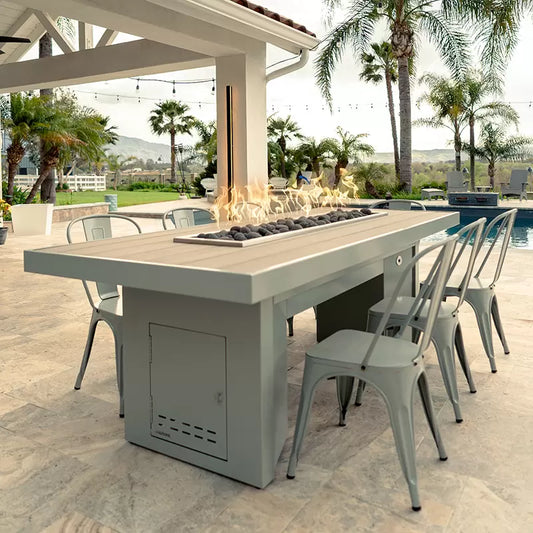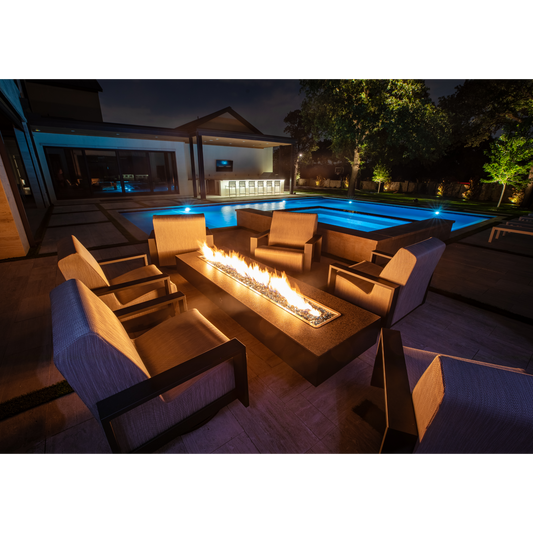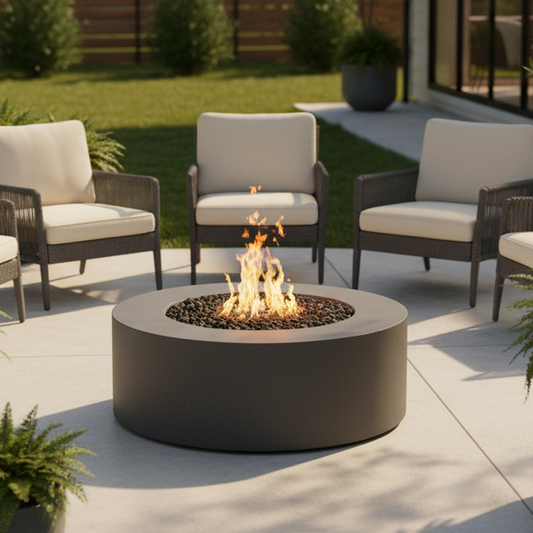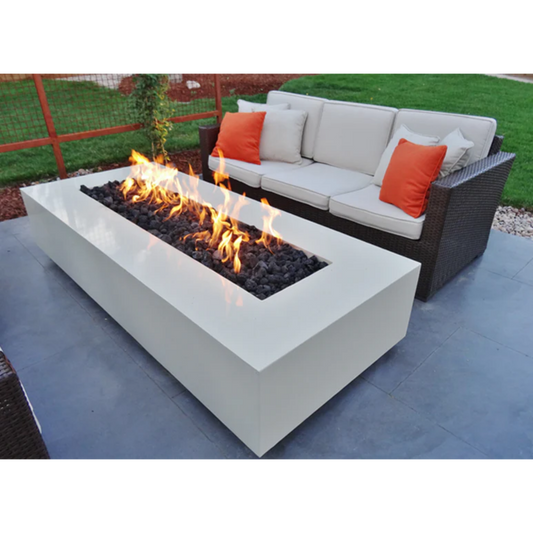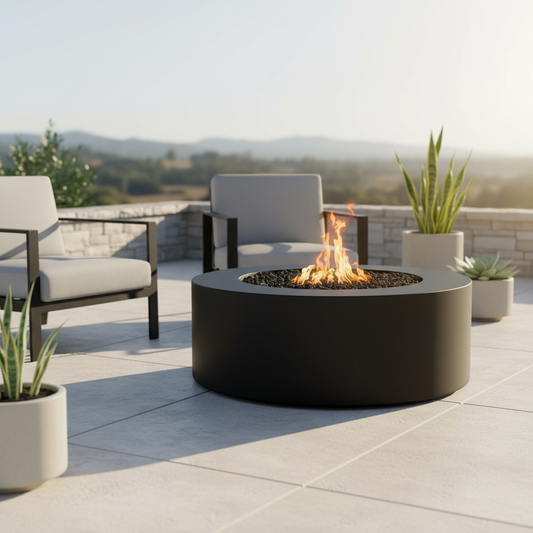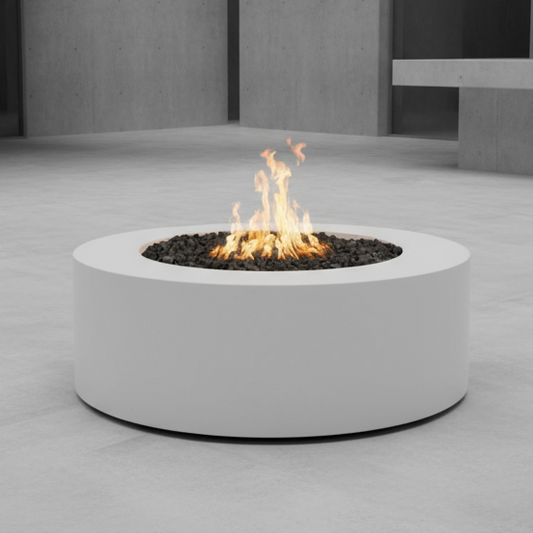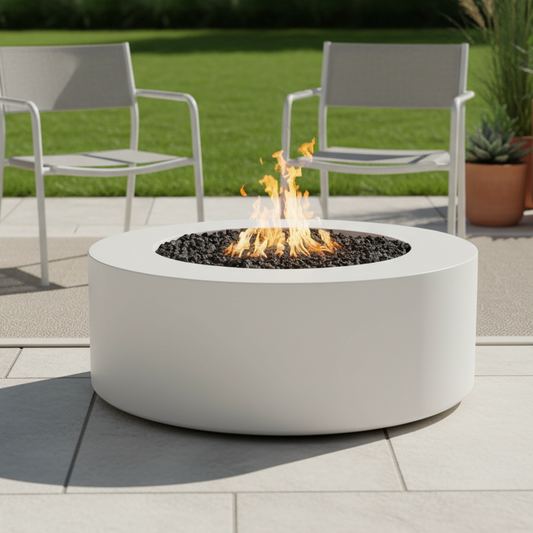Near Trees, Fences or Pools: Safe Placement for Fire Features

Share
The most common backyard question after “where should it go?” is how far a fire pit should be from trees, fences, or pools. The right answer balances distance, wind, and what the nearby materials are made of—plus what your manual and local officials allow. This spoke gives you:
-
baseline clearances (ft + m) you can measure today,
-
a Rule of 3 for judging risky surroundings,
-
how to measure from the correct reference points, and
- a printable checklist + real problem/solution scenarios.
(For house walls, decks, pergolas, ventilation, and shutdown, follow the links sprinkled throughout.)
Key Takeaways -
-
Quick distances (conservative, gas units):
-
Trees/branches: keep a 10–15 ft (3.0–4.5 m) radius clear; trim branches ≥10 ft (3.0 m) above flame.
-
Wood/vinyl fences: ≥10 ft (3.0 m); masonry/metal: ≥6–8 ft (1.8–2.4 m).
-
Pools/water edges: ≥6–10 ft (1.8–3.0 m) to avoid splash, slip zones, and wind-tilted flames.
-
Clear the ground around the fire feature (gravel/pavers) and watch prevailing wind.
-
Use wind guards or screens as risk reducers, not substitutes for clearance.
-
Your owner’s manual and local code/HOA always win.
- See the broader safety ecosystem here: Fire Pit & Fire Pit Table Safety: Distances, Decks & Trees (U.S. Homeowner Guide)
Table of Content
- Quick Answer: Safe Starting Distances
- The Safe Surroundings Rule of 3 (Unique Framework)
- How to Measure Correctly
- Placement Around Trees & Vegetation
- Placement Near Fences, Walls & Property Lines
- Placement Near Pools & Water Features
- Surrounding Safety Checklist
- FAQs
- Conclusion & Next Steps
1. Quick Answer: Safe Starting Distances
These homeowner-friendly ranges work as conservative baselines for gas/propane units in typical open-air backyards. If your manual or local code calls for more space, use the most restrictive rule.
Quick reference – fire feature type vs recommended side clearances (wood, gas, propane)
|
Fire feature type |
Trees / branches (radius from burner centerline) |
Wood/Vinyl fence |
Masonry/Metal fence or wall |
Pool / water edge |
Notes |
|
Gas/propane fire bowl or table |
10–15 ft (3.0–4.5 m) |
≥10 ft (3.0 m) |
≥6–8 ft (1.8–2.4 m) |
≥6–10 ft (1.8–3.0 m) |
Add wind guard to stabilize flame; keep 3 sides open to airflow |
|
Natural gas built-in linear burner |
12–15 ft (3.7–4.5 m) |
≥10 ft (3.0 m) |
≥8 ft (2.4 m) |
≥10 ft (3.0 m) |
Longer flames = more radiant heat; orient with wind |
|
Wood-burning bowl (incl. “smokeless”) |
15–20 ft (4.5–6.1 m) |
≥15 ft (4.5 m) |
≥10 ft (3.0 m) |
≥10–15 ft (3.0–4.5 m) |
Sparks/embers raise risk; use a spark screen/lid |
|
Fire & water bowls (poolside features) |
10–15 ft (3.0–4.5 m) |
≥10 ft (3.0 m) |
≥8 ft (2.4 m) |
≥10 ft (3.0 m) |
Consider chemical splash and burner protection |
Tip: “Rules for fire pits in backyards” vary by city and county. Some jurisdictions also require setbacks from property lines—verify before final placement.
2. The Safe Surroundings Rule of 3 (Unique Framework)
Think of every nearby object through this lens:
- Distance – Measure from the burner centerline to the nearest risk point: tree trunk, canopy edge, fence line, pool coping. The farther, the better.
- Wind Direction – Place the fire downwind from trees and fences so the radiant face points away from them. Avoid corners or alcoves that funnel gusts.
- Material Risk – Rank combustibility and heat sensitivity: dry vegetation & wood (highest), vinyl/composite (warps), metal (can radiate), masonry (most tolerant). Adjust spacing accordingly.
Mini-wrap: If one factor is weak (e.g., vinyl fence), compensate with more distance and a wind guard, or relocate the unit.
3. How to Measure Correctly
1. Find your reference point.
-
- Round bowl: center of the burner.
-
Rectangular burner: midpoint of the flame bar.
2. Measure to what matters.
-
-
Trees: to the canopy edge and any overhanging branch.
-
Fences/walls: to the line of the fence, not just a post.
-
Pools: to the pool edge/coping, not the waterline.
-
Trees: to the canopy edge and any overhanging branch.
3. Account for slope.
Use a tape held level (parallel to the ground) for an accurate horizontal distance.
4. Flag wind paths.
Note the prevailing wind. If the flame leans toward a tree or fence, add clearance or re-orient the burner.
5. Ground the zone.
Create a non-combustible ring (gravel, decomposed granite, pavers) 3–5 ft (0.9–1.5 m) around the fire feature.
4. Placement Around Trees & Vegetation
Trees and shrubs can absorb heat, dry out, and ignite from embers. Even without flame contact, prolonged radiant heat can scorch leaves or discolor bark.
-
Keep a 10–15 ft (3.0–4.5 m) radius clear for gas units; 15–20 ft (4.5–6.1 m) for wood.
-
Trim overhanging branches to ≥10 ft (3.0 m) above the flame zone.
-
Maintain a 5 ft (1.5 m) debris-free ring: no dry leaves, mulch, or pine needles.
-
Consider firescaping plants and fire-resistant ground cover (e.g., gravel/rock beds) immediately around seating areas.
- Choose fire-safe trees and fire-resistant perennials for nearby planting; check guidance from your local extension office.
Mini-wrap: Vegetation changes seasonally. Re-inspect after leaf-out, pruning, and in dry spells.
5. Placement Near Fences, Walls & Property Lines
Fences can warp, melt, or char from radiant heat, and corners can trap hot air.
-
Wood/vinyl/composite: keep ≥10–15 ft (3.0–4.5 m). Vinyl softens quickly; composite can discolor.
-
Masonry/metal: ≥6–8 ft (1.8–2.4 m) is typical for gas units, but increase if you see prolonged warming.
-
Avoid tight corners; give the flame a clear line of sight to open air.
-
Where property line setbacks exist, meet the legal distance and the heat clearance.
Problem/Solution #1 — Fence discoloration or softening
-
Symptoms: slats bowing; vinyl sheen changing; hot touch on metal.
-
Fixes:
-
Move the unit out 2–4 ft (0.6–1.2 m) beyond your current clearance.
-
Install a wind guard to keep the flame vertical.
-
Add a masonry heat shield panel between the fence and fire area (doesn’t replace clearance).
- Re-orient the burner so its long axis faces the fence (reduces radiant concentration).
-
Move the unit out 2–4 ft (0.6–1.2 m) beyond your current clearance.
6. Placement Near Pools & Water Features
Pools introduce slip hazards, chlorine splash, and (for propane) heavier-than-air gas considerations near sunken spaces.
-
Keep ≥6–10 ft (1.8–3.0 m) from the edge/coping.
-
Avoid overhangs where flames could be blown toward bathers.
-
Use wind guards to stabilize the flame and prevent gust-induced tilt over water.
-
Plan safe traffic lanes around the pool; no trip hazards or hoses across walkways.
-
For fire bowls on pedestals near water, confirm anchoring and level pads.
- Be mindful of pool equipment (pumps, heaters, vents)—respect manufacturer offsets.
Problem/Solution #2 — Wind keeps pushing flame toward the pool
-
Symptoms: erratic flame, soot on coping, guest discomfort.
-
Fixes:
-
Relocate the unit downwind of the primary seating and rotate the burner.
-
Add a wind guard and lower flame height during breezy periods.
- Increase pool clearance toward the top of the 6–10 ft range.
-
Relocate the unit downwind of the primary seating and rotate the burner.
7. Surrounding Safety Checklist (Print this)
-
□ Manual & local code checked for side setbacks and fuel rules.
-
□ Burner centerline identified; distances measured to tree canopy, fence line, and pool edge.
-
□ Trees/branches trimmed and ≥10–15 ft (3.0–4.5 m) radius kept clear (gas); ≥15–20 ft (4.5–6.1 m) for wood.
-
□ Fence material noted (wood/vinyl/composite vs masonry/metal) and spacing adjusted.
-
□ Non-combustible ring installed: gravel/pavers 3–5 ft (0.9–1.5 m) around the unit.
-
□ Prevailing wind observed; burner oriented with radiant face away from risks.
-
□ Wind guard / spark screen available (as applicable).
-
□ Lid/cover and extinguisher accessible.
- □ Egress paths clear; no trip hazards around pools.
8. FAQs
How far should a fire pit be from trees or bushes?
Start with 10–15 ft (3.0–4.5 m) for gas and 15–20 ft (4.5–6.1 m) for wood. Trim branches ≥10 ft (3.0 m) above the flame zone.
Can heat from a gas fire pit damage a vinyl fence?
Yes. Vinyl softens and can deform from radiant heat. Keep ≥10–15 ft (3.0–4.5 m) and use a wind guard to stabilize the flame.
Is it safe to put a fire pit near a pool?
Yes, with spacing: ≥6–10 ft (1.8–3.0 m), stable footing, and careful wind management. Keep flames from tilting over the water.
What do wind guards or fire screens actually do?
They reduce gust effects and limit lateral heat toward trees/fences. They do not reduce the clearances required by your manual.
What is firescaping and should I do it?
“Firescaping plants” and fire-resistant ground cover (rock, decomposed granite) create defensible space around your seating area. It’s a smart upgrade—especially in dry climates.
Any simple rule for backyard layout?
Use the Safe Surroundings Rule of 3: maximize Distance, place with Wind Direction in mind, and account for Material Risk (wood/vinyl vs masonry/metal).
9. Conclusion & Next Steps
Safe placement near trees, fences, and pools comes down to generous side clearances, wind-aware orientation, and material-smart decisions—backed by your manual and local code. Start with the conservative ranges above, walk the site with a tape measure, and add risk reducers like wind guards or spark screens where appropriate.
-
Explore certified models: Certified Fire Pit Table Collection
-
Add the right accessories: Accessories – Safety Mats, Wind Guards, Covers
Want help validating your site plan? Contact a Specialist

